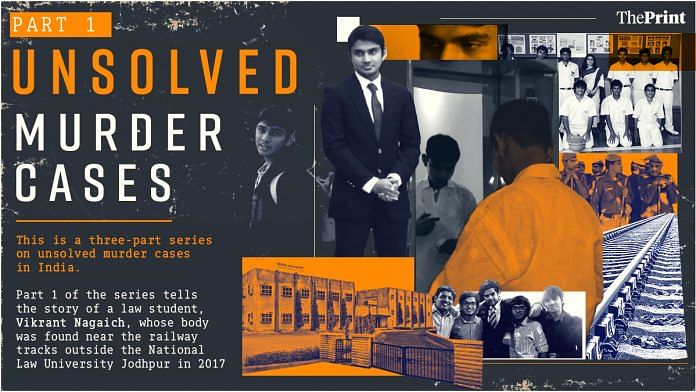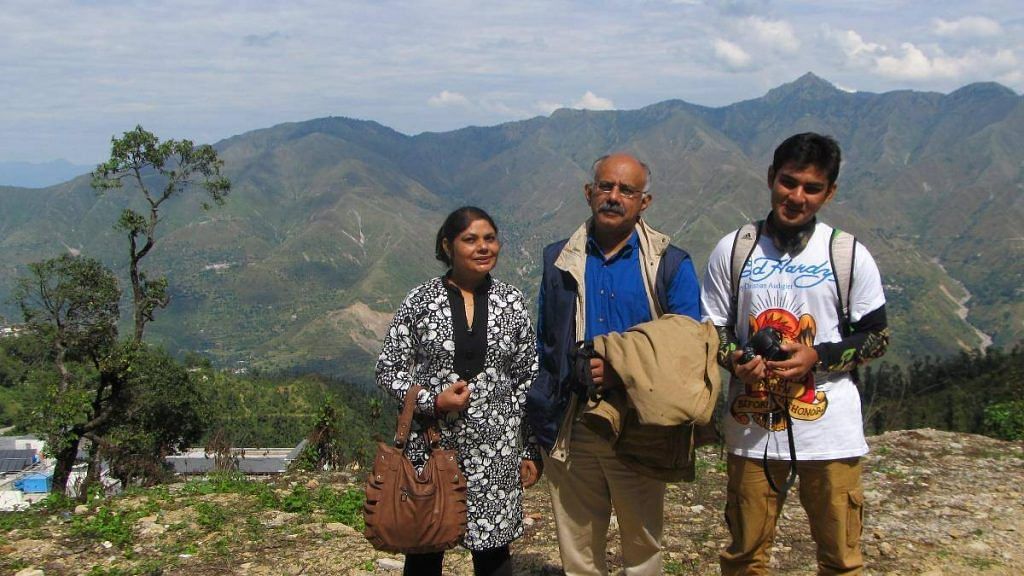New Delhi: First it was declared an accident, then a murder and then again an accident — five years after 22-year-old Vikrant Nagaich’s body was found 10 feet away from the railways tracks outside the National Law University, Jodhpur, the Rajasthan Police is yet to solve the case. They have taken multiple U-turns on the cause of the law student’s death, leaving a trail of unanswered questions.
It’s been five years since Vikrant died and his parents — retired Colonel Jayant Nagaich and Dr Neetu Nagaich — are still fighting a prolonged legal battle demanding answers for their son’s death.
Vikrant was a third-year student at the premier law school situated on NH-65, 12 km away from the main city of Jodhpur. He was found dead under suspicious circumstances on 14 August 2017.
Vikrant’s parents had to file a petition in the Rajasthan High Court, and another one in the Supreme Court for the police to file a final report in the case — one which was set aside by the apex court which questioned the bonafides of the entire investigation.
The police initially claimed before the high court as well as the Supreme Court that the death was accidental in nature. However, in its first final report, the police did a volte face and declared that his death was, in fact, homicidal, but had no clue who did it. A second final report was filed in March last year, which again claimed that Vikrant’s death was accidental.
However, the reports and the investigation have raised more questions than answers on Vikrant’s death. Why did the investigating authorities take multiple U-turns on whether the death was an accident, or a murder? How was a message delivered to the victim’s phone 25 days after his death when the police stated that the phone was damaged beyond repair to retrieve any data? Why was there no blood found at the place where Vikrant’s body was found? If Vikrant’s body was not moved after his death, why was one of his slippers never recovered? Was he targeted by criminals for trying to help a few prosecution lawyers build a case against a “local mob engaged in the trade of illicit liquor”?
Vikrant with his parents-retd Col Jayant Nagaich and Dr Neetu Nagaich | photo source: familyA dreamy-eyed kid straight out of school, Vikrant took a year off in 2013 to travel around the country and “find himself”. He then cracked several competitive exams, including IIT JEE, and scored an all-India rank 19 in the NDA entrance exam, for selection as a fighter pilot. “He did that just to prove that he is as good as me,” Col Nagaich says with a laugh.
He then declared to his parents that he wants to pursue law and then join the administrative services to bring in policy changes. And so he joined the NLU, Jodhpur.
Also Read: Killers roaming free? Delhi’s 14 unidentified murder victim cases found till Nov remain unsolved
The fateful day
Spread across 55 acres, the campus is nested away from the humdrum of the city life, under a starry, relatively pollution-free, sky. Opposite to the campus are a few restaurants and shops. It was around 7:30 pm, on 13 August 2017, when Vikrant stepped out for dinner with two of his friends to one such restaurant, Sweet Dream Land — popularly known as SDL among the students — located nearly 300 metres away from the university.
While his friends returned to college later that night, Vikrant’s body was found the next morning near the railway tracks that run behind the shops opposite the college, close to an establishment called Laxmi Guest House. As per the post-mortem report, seen by ThePrint, Vikrant died due to shock and haemorrhage as a result of multiple injuries. It took note of multiple head and spine injuries on his body, and noted that the injuries were ante-mortem (before death) in nature.
Soon after the incident, the college authorities claimed that according to Vikrant’s friends, he was under depression and was undergoing treatment. The death was, therefore, initially sought to be passed off as accidental by collision with a train, or suicidal. This claim has since been strongly contested by Vikrant’s parents.
A report from the railway authorities, seen by ThePrint, confirmed that the trains that passed through those tracks during the intervening night of 13 and 14 August had not reported any untoward incident. Whenever such an untoward incident happens, the train’s pilot or guard stops the train and gives written information about the incident at the next station.
After no FIR (First Information Report) was lodged in the case for several months, Vikrant’s parents approached the officials of Crime Investigation Department-Crime Branch (CID-CB), Jaipur. It was then that an FIR under Section 302 (murder) of the Indian Penal Code was registered in the case — only 10 months later, on 29 June 2018.
‘Casual, callous’
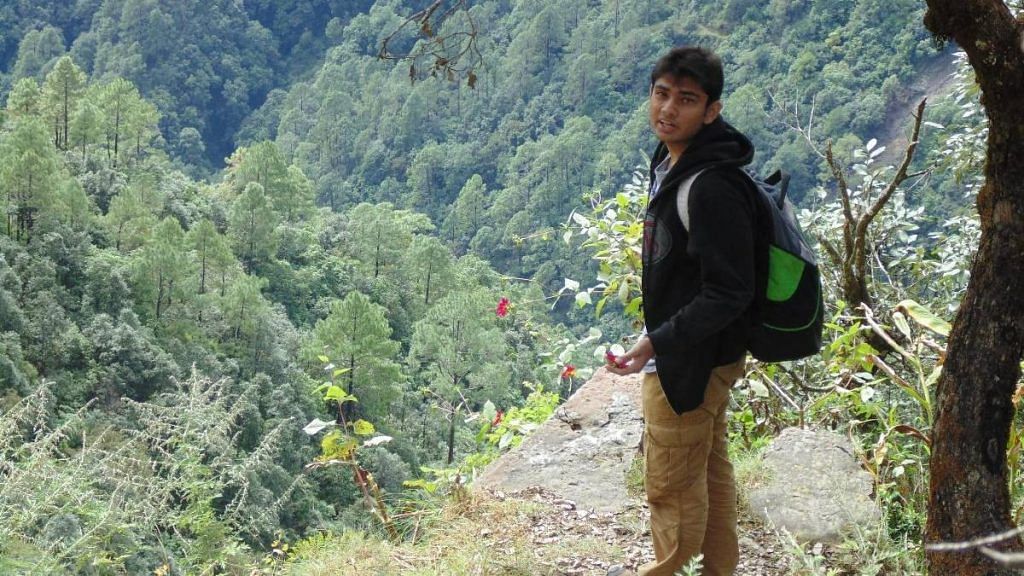
However, on seeing no progress in the probe, Vikrant’s father approached the Rajasthan High Court in March 2019. The court had ordered formation of a special investigation team to probe the case in July 2019. It disposed of the petition in February 2020, with a direction to the investigating officer to thoroughly investigate the case.
Vikrant’s mother then filed a petition in the Supreme Court in June 2020. She claimed several deficiencies in the probe. The plea also claimed that two years after the incident, a few students had overheard a discussion among two of Vikrant’s college friends. One of the friends wanted to share some more details about Vikrant’s death with the police but was allegedly dissuaded by the other friend. The petition, therefore, asserted that “if the students were investigated at the said time, the investigation would have proceeded”.
In response, in an affidavit filed on 3 July 2020, the authorities insisted that the death was accidental. They had made the same claim before the high court as well. However, in the lengthy closure report filed in the Supreme Court, the authorities accepted that though the death was homicidal, they had no clue who did it.
The judgement passed by the apex court in September 2020 was a scathing commentary on the way the probe was handled in the case. Taking a cursory look at the evidence, the top court asserted that “it does not leave much to the imagination that the deceased was not assaulted at the railway track, but elsewhere”.
It pointed out that the “casualness and callousness of the police is reflected from the fact that neither the crime scene was sealed, nor necessary investigation done with promptitude by proper examination of relevant witnesses, including CCTV footage, digital footprints and mobile locations and WhatsApp chats during the relevant period of time on the day of occurrence”.
The court took note of the fact that while there was blood on Vikrant’s clothes, there was no blood at the place where his body was found. It also noted that only one of his slippers was found near his body.
Setting aside the closure report, the Supreme Court directed a ‘de novo’ (from the beginning) investigation by a new team of investigators headed by a senior police officer of the State.
Who saw the body first?
The new investigating team filed a fresh report on 27 March last year, claiming that Vikrant’s death was accidental. It had arrived at this conclusion after recreating the scene of crime with five dummies and a train engine. The engine was then made to run over the dummies in different ways to determine if the condition of Vikrant’s body and his injuries could have been a result of a train accident.
The second final report says that Vikrant died after being “lightly hit” by Runicha Express around 10:58 pm, and that he came in contact with the “lateral part” of the train. The report says that when someone is hit by certain areas of the train lightly, the loco pilot does not get to know of such a collision.
However, Vikrant’s father has since pointed out several inconsistencies and deficiencies in this investigation. In an application, challenging this report before the metropolitan magistrate, he has pointed out that the investigating authorities did not recreate a digital footprint of the crime scene using data from Google or apps like WhatsApp.
“This is a blatant misuse of power. There can be nothing more robust which would say that the Rajasthan Police is bankrupt as far as use of technology is concerned to find the underlying truth behind a crime,” he told ThePrint.
Further, as per a news report seen by ThePrint, former Mandore Station House Officer (SHO) Mukta Pareek was also part of the crime scene recreation near the railway tracks, in spite of the Supreme Court having directed a completely fresh team to conduct the probe.
The new final report also shoots down several witness statements which contradict the police’s claim that Vikrant’s death was an accident. For instance, the police report has claimed that the first person to discover Vikrant’s body was a local labourer, Sonah Lal, around 9:30 am, after which he informed the owner of the guest house.
However, another NLU student, who was staying in Laxmi Guest House, told the police that when he was returning back from the NLU grounds in the morning of 14 August around 8 am, he was informed by people at the guest house about a body being found and that he saw a group of people standing near the body. He saw the body from afar, but didn’t recognise it and went about his day.
The second final report shoots down his testimony by questioning the student’s conduct after he was told about the body. The report says that the fact that the student got dressed after it and attended classes without mentioning the incident to anybody shows that he wasn’t “serious” enough about the incident. However, the student’s claim was not investigated in detail beyond this.
Message received 25 days after death
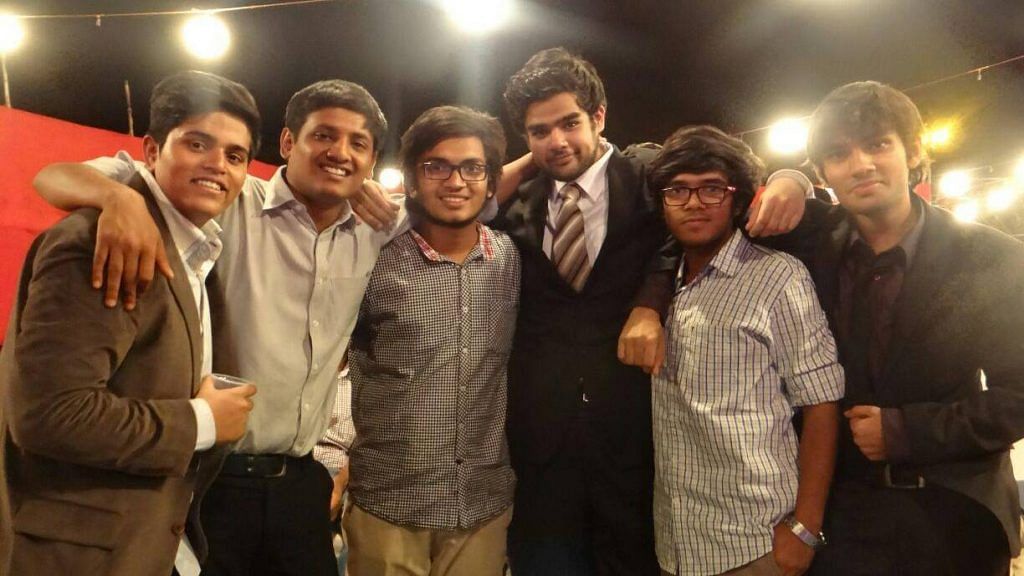
Further, the authorities claimed that Vikrant’s phone was destroyed beyond repair and hence, no data could be retrieved. However, according to its own second final report, a ‘Hey’ message that his friend sent to him on 14 August 2017 was received on Vikrant’s phone 25 days after his death, on 9 September 2017. This is as per the receipt report on the friend’s phone.
The final report, however, claimed that no data could be recovered from Vikrant’s phone because the data chip memory was “very badly damaged”.
Vikrant’s parents have also alleged that he was working on helping a few local prosecution lawyers to build a case against a “local mob engaged in the trade of illicit liquor”. They then raise a question on the potential involvement of this or allied local groups of criminals dealing in contraband substances and drugs.
However, the final report filed by the police brushed aside this theory only on the premise that a few of Vikrant’s friends denied any knowledge about Vikrant raising his voice against any drug mafia.
‘Who is to blame?’
In August last year, Vikrant’s mother filed a contempt petition in the Supreme Court, for having called his death an “accident” again, after informing the court that it was a case of homicide. The petition was filed against the Director General of Police, Rajasthan, the Deputy Commissioner of Police (East) Jodhpur and the Assistant Commissioner of Police, Mandore. The court issued notice on this petition in November last year. However, the case hasn’t come up for hearing since.
Colonel Jayant Nagaich has also filed an application before the metropolitan magistrate, Jodhpur, pointing out several errors in the fresh investigation. He has, therefore, demanded that this final report should be rejected and that the authorities should be directed to conduct a fresh investigation on the errors.
Keeping his legacy alive
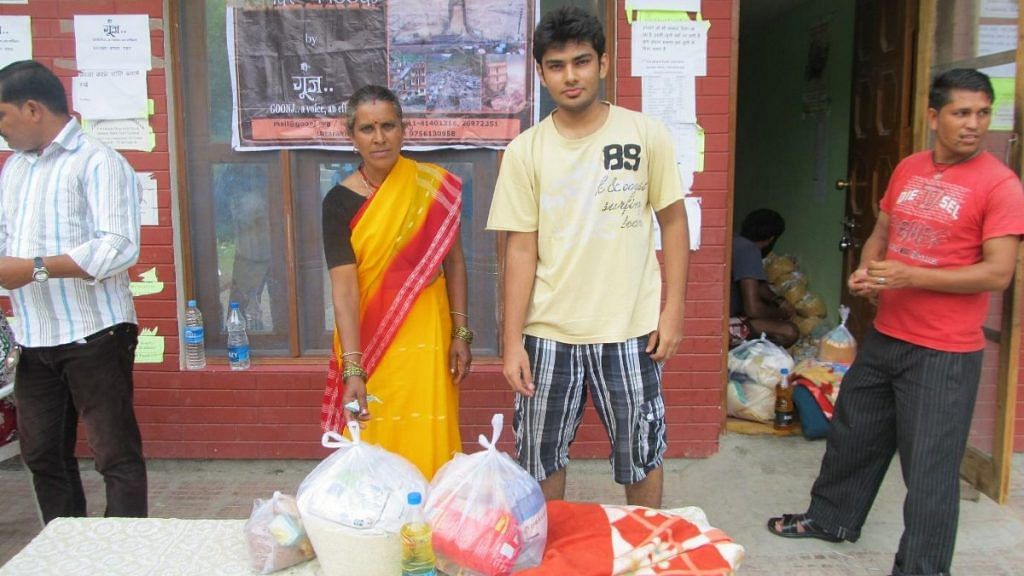
Vikrant’s parents have since also been trying to keep their son’s “legacy” alive. They have established a ‘Vikrant Nagaich Welfare Trust’.
“Vikrant was a brilliant child. He achieved far more in his 22 years of age than what I have achieved in my 63 years now,” his father says. He recollects how Vikrant volunteered for about 50 days in flood-hit Kedarnath during one of the worst natural tragedies in the recent times.
He also took some time off during college to teach students for their class 10 exams at the Rajkiya Anusuchit Jan Jatiya Aawasiya Uccha Vidyalaya, Jobhipath, in the Naxalite-hit area of Jobhipat in Jharkhand. This was under Jean Dreze’s ‘Hard work, No pay’ campaign.
He then saved all his internship and competition win money to get three children from the Jobhipath school to Delhi for a week-long homestay to introduce them to the ways of a metropolitan city and take them to a session of the Delhi Assembly, among other things, all while he was interning under Ashish Khaitan at the Delhi Dialogue Commission.
“This was to assist in experiential learning for the children and motivate them into striving harder and see what they can make of their life,” said the parents.
As for Nagaich, he took voluntary retirement from the army in 2003 and worked with the corporate sector till 2017, the year Vikrant passed away. Following Vikrant’s death he quit, as he “couldn’t concentrate” on his work. He now intends on keeping the fight alive, “to get justice for Vikrant not wanting to fail him yet again,” he said.
“They (the authorities) have been wanting to shut the case, which we are not going to accept. We are going to keep contesting,” the retired colonel told ThePrint.
He added: “I will ask them, to establish accountability. In this age of technology at our disposal it is essential to find out who is responsible for this heinous crime. We cannot just let it go.”
(This is an updated version of the report)
(Edited by Geethalakshmi Ramanathan)
Also Read: Don’t just blame India’s courts, it’s the police that can’t solve criminal cases in time


